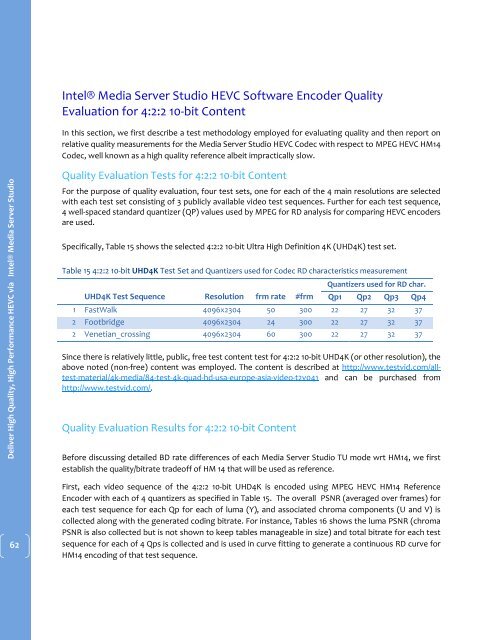You also want an ePaper? Increase the reach of your titles
YUMPU automatically turns print PDFs into web optimized ePapers that Google loves.
<strong>Intel®</strong> <strong>Media</strong> <strong>Server</strong> <strong>Studio</strong> <strong>HEVC</strong> Software Encoder <strong>Quality</strong><br />
Evaluation for 4:2:2 10-bit Content<br />
In this section, we first describe a test methodology employed for evaluating quality and then report on<br />
relative quality measurements for the <strong>Media</strong> <strong>Server</strong> <strong>Studio</strong> <strong>HEVC</strong> Codec with respect to MPEG <strong>HEVC</strong> HM14<br />
Codec, well known as a high quality reference albeit impractically slow.<br />
<strong>Deliver</strong> <strong>High</strong> <strong>Quality</strong>, <strong>High</strong> <strong>Performance</strong> <strong>HEVC</strong> <strong>via</strong> <strong>Intel®</strong> <strong>Media</strong> <strong>Server</strong> <strong>Studio</strong><br />
<strong>Quality</strong> Evaluation Tests for 4:2:2 10-bit Content<br />
For the purpose of quality evaluation, four test sets, one for each of the 4 main resolutions are selected<br />
with each test set consisting of 3 publicly available video test sequences. Further for each test sequence,<br />
4 well-spaced standard quantizer (QP) values used by MPEG for RD analysis for comparing <strong>HEVC</strong> encoders<br />
are used.<br />
Specifically, Table 15 shows the selected 4:2:2 10-bit Ultra <strong>High</strong> Definition 4K (UHD4K) test set.<br />
Table 15 4:2:2 10-bit UHD4K Test Set and Quantizers used for Codec RD characteristics measurement<br />
UHD4K Test Sequence Resolution frm rate #frm<br />
Quantizers used for RD char.<br />
Qp1 Qp2 Qp3 Qp4<br />
1 FastWalk 4096x2304 50 300 22 27 32 37<br />
2 Footbridge 4096x2304 24 300 22 27 32 37<br />
2 Venetian_crossing 4096x2304 60 300 22 27 32 37<br />
Since there is relatively little, public, free test content test for 4:2:2 10-bit UHD4K (or other resolution), the<br />
above noted (non-free) content was employed. The content is described at http://www.testvid.com/alltest-material/4k-media/84-test-4k-quad-hd-usa-europe-asia-video-t2v041<br />
and can be purchased from<br />
http://www.testvid.com/.<br />
<strong>Quality</strong> Evaluation Results for 4:2:2 10-bit Content<br />
Before discussing detailed BD rate differences of each <strong>Media</strong> <strong>Server</strong> <strong>Studio</strong> TU mode wrt HM14, we first<br />
establish the quality/bitrate tradeoff of HM 14 that will be used as reference.<br />
62<br />
First, each video sequence of the 4:2:2 10-bit UHD4K is encoded using MPEG <strong>HEVC</strong> HM14 Reference<br />
Encoder with each of 4 quantizers as specified in Table 15. The overall PSNR (averaged over frames) for<br />
each test sequence for each Qp for each of luma (Y), and associated chroma components (U and V) is<br />
collected along with the generated coding bitrate. For instance, Tables 16 shows the luma PSNR (chroma<br />
PSNR is also collected but is not shown to keep tables manageable in size) and total bitrate for each test<br />
sequence for each of 4 Qps is collected and is used in curve fitting to generate a continuous RD curve for<br />
HM14 encoding of that test sequence.


